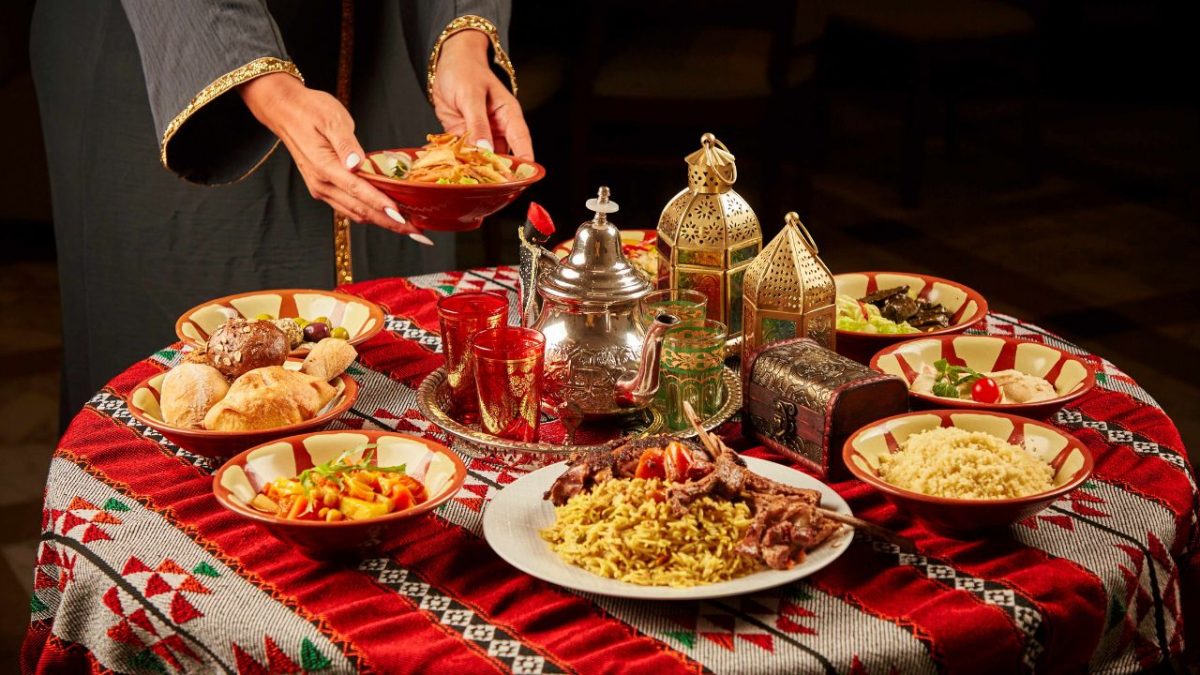
Delicious Iftar Menu 2025 – A Taste of Traditional Pakistani Cuisine
Iftar, the meal that breaks the fast during the holy month of Ramadan, holds a special place in Pakistani culture. It is a time for families and friends to come together and share a delicious spread of traditional foods that offer nourishment after a long day of fasting. The Iftar menu in Pakistan is diverse, offering a variety of dishes that blend rich flavors, textures, and spices. Whether it’s the savory snacks, hearty main courses, or sweet desserts, every dish plays an important role in making the Iftar meal a memorable occasion.
1. Dates (Khajoor) and Water:
Traditionally, the fast is broken with dates (khajoor) and water, following the Sunnah of the Prophet Muhammad (PBUH). Dates are not only a rich source of energy but also packed with essential nutrients like fiber, potassium, and magnesium. The natural sugars in dates provide a quick boost of energy, which is crucial after a long day of fasting. Water is equally important, as it rehydrates the body after a day of abstaining from food and drink.
2. Pakoras (Fried Fritters):
One of the most popular items on the Pakistani Iftar menu is pakoras (or bhajiyas). These crispy, golden fritters are made from a variety of ingredients such as potatoes, spinach, onions, and chickpea flour (besan), all deep-fried to perfection. Pakoras are often spiced with cumin, coriander, and chili powder, giving them a rich and savory flavor. They are typically served with a side of chutney, adding an extra tangy element to the snack.
3. Samosas:
Samosas are another favorite snack to break the fast. These triangular pastries are filled with either spiced potatoes, minced meat, or lentils. The crust is crispy and golden, and the filling is a burst of flavors with aromatic spices like cumin, coriander, and garam masala. Samosas are perfect for sharing, making them a common choice at Iftar gatherings.
4. Fruit Chaat:
For a refreshing addition to the meal, fruit chaat is a popular option. This colorful dish features a mix of seasonal fruits, often including pomegranate, apples, oranges, bananas, and papaya. The fruits are tossed together with a tangy dressing made from lemon juice, chaat masala, black salt, and sugar. The result is a refreshing and sweet-tangy salad that is both hydrating and satisfying.
5. Dahi Puri:
Dahi puri is a well-loved street food in Pakistan, and it often makes an appearance during Iftar. This dish consists of crispy puris (small fried dough balls) that are topped with yogurt, tamarind chutney, and a sprinkle of various spices. The combination of crispy, creamy, and tangy flavors makes dahi puri a delightful treat that balances out the heat of the fried items.
6. Chicken or Beef Seekh Kebabs:
For a heartier option, seekh kebabs are a popular choice. These skewers of minced meat (usually chicken or beef) are spiced with a mix of herbs and seasonings, then grilled or baked to perfection. The smoky flavor and tender texture of the kebabs make them a favorite addition to the Iftar spread.
7. Pulao or Biryani:
No Pakistani Iftar is complete without a flavorful rice dish, and pulao or biryani are common choices. Biryani is a fragrant, spiced rice dish typically made with chicken, mutton, or beef, along with a blend of spices like cumin, cinnamon, cardamom, and cloves. Pulao, a milder alternative, uses fewer spices and is typically made with basmati rice and a variety of vegetables or meat. Both dishes are filling and satisfying, making them a great option for the main course.
8. Sweet Dishes:
To end the meal on a sweet note, Pakistani Iftar menus often feature indulgent desserts. Gulab jamun, small fried dough balls soaked in syrup, are a beloved choice, offering a rich and aromatic sweetness. Kheer, a creamy rice pudding flavored with cardamom and garnished with nuts, is another favorite dessert that provides a comforting finish to the meal. Additionally, jalebi, a deep-fried dessert soaked in sugary syrup, is another popular option.
9. Rooh Afza or Fresh Juices:
To wash down the meal, Rooh Afza, a sweet, herbal drink, is often served. It’s made from various flowers, fruits, and herbs and is known for its refreshing taste and vibrant red color. Fresh juices, such as watermelon, orange, or apple juice, are also common at Iftar, helping to rehydrate and refresh the body.
In conclusion, the Iftar menu in Pakistan is a delightful mix of savory, sweet, and refreshing foods that cater to a wide range of tastes. The meal not only replenishes the body but also fosters a sense of community and togetherness, as families and friends gather to share in the blessings of Ramadan.
